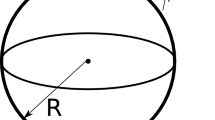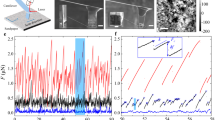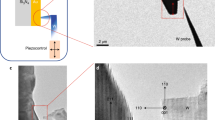Abstract
Forces acting within the area of atomic contact between surfaces play a central role in friction and adhesion. Such forces are traditionally calculated using continuum contact mechanics1, which is known to break down as the contact radius approaches atomic dimensions. Yet contact mechanics is being applied at ever smaller lengths, driven by interest in shrinking devices to nanometre scales2,3, creating nanostructured materials with optimized mechanical properties3,4, and understanding the molecular origins of macroscopic friction and adhesion5,6. Here we use molecular simulations to test the limits of contact mechanics under ideal conditions. Our findings indicate that atomic discreteness within the bulk of the solids does not have a significant effect, but that the atomic-scale surface roughness that is always produced by discrete atoms leads to dramatic deviations from continuum theory. Contact areas and stresses may be changed by a factor of two, whereas friction and lateral contact stiffness change by an order of magnitude. These variations are likely to affect continuum predictions for many macroscopic rough surfaces, where studies7,8 show that the total contact area is broken up into many separate regions with very small mean radius.
This is a preview of subscription content, access via your institution
Access options
Subscribe to this journal
Receive 51 print issues and online access
$199.00 per year
only $3.90 per issue
Buy this article
- Purchase on Springer Link
- Instant access to full article PDF
Prices may be subject to local taxes which are calculated during checkout




Similar content being viewed by others
References
Johnson, K. Contact Mechanics Ch. 4, 5, 13 (Cambridge Univ. Press, Cambridge, 1985)
Nanotechnology (special issue). Sci. Am. 285(3), 32–85 (2001).
Bhushan, B. (ed.) Springer Handbook of Nanotechnology (Springer, Berlin, 2003)
Valiev, R. Nanomaterial advantage. Nature 419, 887–889 (2002)
Bhushan, B., Israelachvili, J. N. & Landman, U. Nanotribology: Friction, wear and lubrication at the atomic scale. Nature 374, 607–616 (1995)
Urbakh, M., Klafter, J., Gourdon, D. & Israelachvili, J. The nonlinear nature of friction. Nature 430, 525–528 (2004)
Greenwood, J. A. A unified theory of surface roughness. Proc. R. Soc. Lond. A 393, 133–157 (1984)
Hyun, S., Pei, L., Molinari, J.-F. & Robbins, M. O. Finite-element analysis of contact between elastic self-affine surfaces. Phys. Rev. E 70, 026117 (2004)
Landman, U., Luedtke, W. D. & Gao, J. Atomic-scale issues in tribology: interfacial junctions and nano-elastohydrodynamics. Langmuir 12, 4514–4528 (1996)
Miller, R. & Phillips, R. Critical analysis of local constitutive models for slip and decohesion. Phil. Mag. A 73, 803–828 (1996)
Vafek, O. & Robbins, M. O. Molecular dynamics study of the stress singularity at a corner. Phys. Rev. B 60, 12002–12006 (1999)
Persson, B. N. J. Elastoplastic contact between randomly rough surfaces. Phys. Rev. Lett. 87, 116101 (2001)
Carpick, R. W. & Salmeron, M. Scratching the surface: fundamental investigations of tribology with atomic force microscopy. Chem. Rev. 97, 1163–1194 (1997)
Lantz, M. A., O'Shea, S. J. & Welland, M. E. Simultaneous force and conduction measurements in atomic force microscopy. Phys. Rev. B 56, 15345–15352 (1997)
Schwarz, U. D., Zwörner, O., Koster, P. & Wiesendanger, R. Quantitative analysis of the frictional properties of solid materials at low loads. I. Carbon compounds. Phys. Rev. B 56, 6987–6996 (1997)
Enachescu, M. et al. Atomic force microscope study of an ideally hard contact: The diamond (111)/Tungsten carbide interface. Phys. Rev. Lett. 81, 1877–1880 (1998)
Kiely, J. D. & Houston, J. E. Nanomechanical properties of Au (111), (001), and (110) surfaces. Phys. Rev. B57, 12588–12594 (1998)
Carpick, R. W. & Eriksson, M. A. Measurements of in-plane material properties with scanning probe microscopy. MRS Bull. 29, 472–477 (2004)
Socoliuc, A., Bennewitz, R., Gnecco, E. & Meyer, E. Transition from stick-slip to continuous sliding in atomic friction. Phys. Rev. Lett. 92, 134301 (2004)
Maugis, D. Adhesion of spheres: The JKR-DMT transition using a Dugdale model. J. Colloid Interf. Sci. 150, 243–269 (1992)
Müser, M. H., Wenning, L. & Robbins, M. O. Simple microscopic theory of Amontons's laws for static friction. Phys. Rev. Lett. 86, 1295–1298 (2001)
Hirano, M., Shinjo, K., Kaneko, R. & Murata, Y. Observation of superlubricity by scanning tunnelling microscopy. Phys. Rev. Lett. 78, 1448–1451 (1997)
Dienwiebel, M. et al. Superlubricity of graphite. Phys. Rev. Lett. 92, 126101 (2004)
Wenning, L. & Müser, M. H. Friction laws for elastic nano-scale contacts. Europhys. Lett. 54, 693–699 (2001)
Horn, R. G., Israelachvili, J. N. & Pribac, F. Measurement of the deformation and adhesion of solids in contact. J. Coll. Interf. Sci. 115, 480–492 (1987)
Homola, A. M., Israelachvili, J. N., McGuiggan, P. M. & Gee, M. L. Fundamental experimental studies in tribology: The transition from “interfacial” friction of undamaged molecularly smooth surfaces to “normal” friction with wear. Wear 136, 65–83 (1990)
Maeda, N., Chen, N., Tirrell, M. A. & Israelachvili, J. N. Adhesion and friction mechanisms of polymer-on-polymer surfaces. Science 297, 379–382 (2002)
Shull, K. R. Contact mechanics and the adhesion of soft solids. Mater. Sci. Eng. R. 36, 1–45 (2002)
Newby, B.-m. A., Chaudhury, M. K. & Brown, H. R. Macroscopic evidence of the effect of interfacial slippage on adhesion. Science 269, 1407–1409 (1995)
Acknowledgements
We thank R. W. Carpick, J. N. Israelachvili, P. M. McGuiggan and M. H. Müser for useful discussions. This material is based upon work supported by the National Science Foundation.
Author information
Authors and Affiliations
Corresponding author
Ethics declarations
Competing interests
Reprints and permissions information is available at npg.nature.com/reprintsandpermissions. The authors declare no competing financial interests.
Supplementary information
Supplementary Notes
Supplementary Methods describing simulation potentials and Supplementary Figure S1 showing comparison of results for rigid and flexible tips. (PDF 127 kb)
Supplementary Figure S2
Variation of normal displacement, contact radius, friction and lateral stiffness with normal load for non-adhesive spherical tips. (PDF 113 kb)
Rights and permissions
About this article
Cite this article
Luan, B., Robbins, M. The breakdown of continuum models for mechanical contacts. Nature 435, 929–932 (2005). https://doi.org/10.1038/nature03700
Received:
Accepted:
Issue Date:
DOI: https://doi.org/10.1038/nature03700
This article is cited by
-
An atomistic study of sticking, bouncing, and aggregate destruction in collisions of grains with small aggregates
Scientific Reports (2024)
-
Atomistic understanding of rough surface on the interfacial friction behavior during the chemical mechanical polishing process of diamond
Friction (2024)
-
Molecular Dynamics Study of Nano-Grinding Behavior for Silicon Wafer Workpieces with Nanoscale Roughness Under Diamond Abrasive Rotation and Translation
Tribology Letters (2024)
-
Predicting frictional aging from bulk relaxation measurements
Nature Communications (2023)
-
Molecular dynamics simulation-based study of single-crystal 3C-SiC nano-indentation with water film
Applied Physics A (2023)
Comments
By submitting a comment you agree to abide by our Terms and Community Guidelines. If you find something abusive or that does not comply with our terms or guidelines please flag it as inappropriate.



